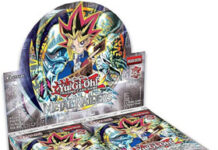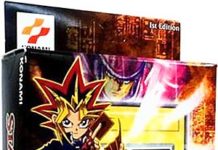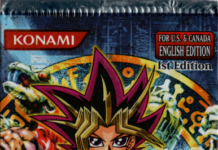One of the coolest parts of Goat Format, in my opinion, is the limited card pool that we can work with. There are only so many cards that you can play in the format, and of those only a handful are actually considered useful. But as the format has changed and evolved over the past ten years or so, many players have found new cards that, with some thinking and testing, can be considered worthy additions to a deck.
This article is not about those cards.
This article is about the “fringe” of the format – those cards that are often overlooked when combing through the commons box, or the ones that you think “hey that’d be kinda cool!” but then you dismiss it because you can’t find room or the theory just doesn’t quite work. In an undefined meta you would likely cut these cards too. But if you find yourself having trouble overcoming problem decks or cards over and over during play, these are definitely some cards to think about.
Am I saying you should play them? Not at all. Am I saying you should think about playing them before dismissing them out of hand? Most definitely. Let’s get started, shall we?
Ceasefire
Ceasefire is a card that saw a decent amount of play back in 2005. It was on everyone’s radar; everyone knew about it and the threat it represented. Flipping all face down monsters face-up, without Flip-Effect monsters activating, and then burning your opponent for 500 LP damage for each effect monster on the field is a potent effect, and one that a lot of people tried to tech into their deck. It was seen in more than one Top 8 decklist back in 2005, and it’s stayed on the fringe of the format ever since.
But why is it fringe?
Well, to start, it’s limited to one. So that means that it becomes more of a one-shot weapon than something you can truly rely on. And it’s a passive -1, in that it doesn’t actually get rid of anything. At the same time, though, it does stop Flip Effect monsters from going off. This can make it the perfect counter to something like a Tsukuyomi lock, where your opponent keeps flipping their Magician of Faith or Mask of Darkness face-down. Really, against more passive decks, it can be a good way to shift the momentum to your side. However, you’d have to be able to follow up Ceasefire with some form of aggression in order to really capitalize on it.
And the burn damage is really nice, especially in close games.
And that’s how most people nowadays use it, if they do at all – as a one-off tech that can disrupt plays in critical moments and that can deal some burn damage if the duel goes into time. But even then, if you’re playing an event where rounds are timed, Wave Motion Cannon may be a better choice due to the clock it puts on the game. If you’re playing Tsuk Lock or Empty Jar, the card can be a good surprise if you feel they’re about to disrupt your board.
But ultimately, Ceasefire has become fringe due to most people figuring out how to work around it. Most of the top-notch players will simply be able to roll past a Ceasefire activation, and since it doesn’t do much other than disrupt in terms of netting advantage, most people tend to see better options in other cards.
Dark Mimic LV1
Here’s a card I really want to talk about. If you don’t know, Dark Mimic LV1 is a Level 1 DARK monster. Its stats are weak at 100/1000, but his Flip Effect is what makes him amazing: he lets you draw a card. But he’s still decided fringe, mostly because of his ATK stats.
At first glance Dark Mimic seems like a waaaaaaay better version of Dekoichi, the Battlechanted Locomotive. In fact, I immediately jumped onto this particular wagon for one big reason: he’s a Level 1.
Level 1 means he’s Morphable into Thousand-Eyes Restrict, one of the most popular and powerful monsters in Goat Format.
I sat there, looking at this card, thinking to myself, “in every instance but ATK he’s better than Dekoichi. Why doesn’t everyone play this?!”
And the reason why? He’s not better than Dekoichi. In fact, he’s fringe for a reason.
That 1300 ATK difference really, truly, makes a big difference. Mimic’s only job is to draw a card – that’s it. If he dies by battle, great. But if he survives, you need to have a Tsukuyomi or Book of Moon to flip him back down, or a tribute monster like Airknight, or a meta to get rid of him. If you flip him and he stays in face-up attack position, he turns into a massive damage sink. He can exert all of zero pressure on your opponent. He cannot take out small monsters, he cannot wall against weak monsters. He’s small, and that’s not good especially since you already run a lot of small monsters (Magician of Faith in particular).
Dekoichi’s 1400 ATK – and Machine-type status – make him better. He can be flipped and stand his ground against weaker monsters and can force the opponent to set against him. He’s a machine, and thus gets a boost with Limiter Removal. But Dark Mimic’s ATK value is really the biggest difference and the main thing that makes him fringe. After extensive testing with both, I’ve learned that Dekoichi is far superior to Mimic in all but a handful of decks, notably Necrofear Return.
In standard Goat you already run Magician of Faith, Sinister Serpent and Magical Merchant as your Level 1 monsters. Your DARK monsters tend to be bigger and are usually your attackers (notably Exarion Universe in Exarion Goats). Dekoichi really doesn’t have a place in Standard Goat anyway, but even in decks he is useful in, he’s far better than Mimic. Ultimately, Mimic is just not useful enough to really warrant inclusion in all but a handful of decks.
Messenger of Peace
Messenger of Peace cropped up in a handful of different decks and recently has made some waves as a part of the Perovic side deck. It’s a potent card especially in more passive decks, as it can completely shut down aggressive players and force them to attack with sub-1500 ATK monsters until they can pop it.
But man, they can pop it in so many ways. As Messenger is a continuous spell, it means that it has to stay on the field. And while you have control over when you turn it off (just opt to not pay the 100 LP), half the time the opponent will drop a Breaker or a Dust Tornado or Mystical Space Typhoon to get rid of it. Barring that, they can just Heavy Storm it away. And that’s not necessarily a bad thing. Sucking up S/T removal to protect other, more valuable backrow is a viable strategy. It may not be the best strategy, but it’s an option.
There are lots of ways around Messenger of Peace. If you think that your opponent will be siding out S/T destruction (many people like to side out Dust Tornado for Trap Dustshoot, for instance), it can be a decent play. It’s also decent against many aggressive builds such as Dimension Fusion Turbo and Bazoo Return. However, ultimately the card is fringe because it just doesn’t do enough. Stall has become less important in more standard decks such as Goat Control, Zoo and Chaos. And Messenger is better when Exarion Universe is in the format. But even then, it works best if you’re also siding more passive cards like Dekoichi (which is probably one of the best cards alongside Messenger), as it can exert pressure while still getting under Messenger’s 1500 ATK limitation.
Of course, Messenger can work well in stall decks, but those are already fringe and for good reason. PACMAN decks can make use of it, as can Tsuk Lock. And it’s nice to be able to turn it off when you need to, which makes it more potent in these stall-based decks. It can work well as a sidedeck card as well, especially in metas where aggression is valued. If you’re seeing a lot of Zoo or Chaos or DFT, Messenger can be a good way to stop them from going off so quickly.
Swords of Revealing Light
Swords of Revealing Light was a staple back in 2005. Few people did not run it and if you didn’t run it people looked at you like you were crazy. Being able to stop attacks for three turns was (and, to be fair, still kind of is) an awesome effect. It can allow you to set up Tsuk Locks, it can help you setup boards if you’re behind on advantage or need time to draw outs to things. But if it was a staple back in the day, what makes it less so now?
Simply put, the format has evolved. Most players nowadays have realized that they can prevent attacks in other, more proactive ways, such as Sakuretsu Armor. Or they can simply absorb attacks and make their opponent think they’re making optimal plays when they’re not. Really, as the format has changed and evolved and people have redefined the best strategies in Goat Format, Swords of Revealing Light has simply ceased to be as relevant as it was before.
But that doesn’t mean that it’s not useful. It sees more play in decks like Tsuk Lock and PACMAN and burn, all of which are fringe decks that aren’t seen often in the meta nowadays. And that’s where Swords shines best, in fringe decks. Is it really that surprising? Decks that need time to get their combos off, or time to prevent their opponent from breaking their boards, will stand to benefit from Swords the most. But in Goat Control or any other current meta deck, chances are it’ll just take away from your overall strategy rather than enhance it, and that’s why the card is fringe.
Spirit Reaper
Spirit Reaper is a card that saw play back in 2005, and 2006, and on and off through the years. When it was first released, a lot of people had a hard time figuring out how to get over him. But as the years have evolved and we’ve seen strategies come and go, players have come to accept that it’s just another stall card, and it is slowly being pushed out of mainstream and into the “fringe” category of Goat Format cards.
Spirit Reaper is a card that is either really good or really bad depending on if Exarion Universe is included in the format. Now, online, at least as of this writing, pre-Exarion Goat Format (also known as “Authentic Goats”) is all the rage on Dueling Book. Most people like playing without Exarion nowadays for several reasons. A) it’s authentic Goat Format, the same card pool we say back in the April 2005 format. B) Exarion is incredibly powerful if you know what you’re doing and single-handedly warps the format. C) multiple cards become obsolete with Exarion Universe in the format, including Spirit Reaper.
Exarion makes Spirit Reaper fringe, straight up. This is because Exarion Universe turns Spirit Reaper into a massive liability especially when you already have Airknight Parshath in the format (which punishes Spirit Reaper very, very well already). Having four potential piercers in the format immediately makes Spirit Reaper – which is not good Metamorphosis fodder and does little against an aggressive board but stall – a massive, massive damage sink. Airknight pierces for 1700 and draws, Exarion pierces for 1200 if you drop his ATK. That’s 2900 if they’re both on board swinging into an unprotected Reaper.
But if Exarion is gone, Reaper all of a sudden gets repurposed into a card that dares a player to drop Airknight or force them to play something to stop Reaper’s second effect (the discard effect if he deals direct damage) from going off. So it can force your opponent to play suboptimally if their only real monster out to it is Airknight. And with Exarion gone, Reaper can stall so many other cards, notably Skilled Dark Magician and D.D. Assailant.
And it’s obviously very good in Zombies if you’re playing without Exarion in the format.
So Reaper is decidedly less fringe if Exarion is excluded, and decidedly more fringe if it isn’t. Personally, the IRL tourneys I attend play with Exarion Universe, so Reaper is much more fringe in my local scene. Online, though, it’s seen much more often and can cause serious headaches in Authentic Goat Format.
Ultimately, what you play is up to you. These are not cards that you should try to build a deck around or really focus on including in your deck. These are cards that may work if you’ve tried most everything else and still can’t find the out to something. They require solid testing and understanding of the theory behind them in order to maximize their potential, but they can be useful in the right situations. Try them for yourself and see what you think.
That’s it for this time. As always, check out the Pojo Goat Format Thread for the latest Goat Format discussion, and e-mail me any time at anteausonyugioh@gmail.com. There’s also a Discord server for Goat Format – check it out here.



